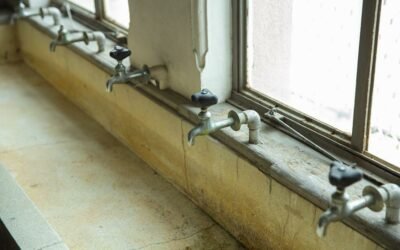Is black mold an emergency?
Discover the answer in this informative article. You'll learn how to identify the signs of black mold and understand the health risks associated with it.
Find out when it's crucial to seek professional help and the steps to take in an emergency situation.
Stay informed and take action to protect yourself and your loved ones from the potential dangers of black mold.
Key Takeaways
- Black mold, also known as Stachybotrys chartarum, grows in damp and humid environments.
- Exposure to black mold can lead to respiratory issues, allergic reactions, and more serious health conditions.
- Look for visible patches of dark green or black mold in damp areas, especially in bathrooms and basements.
- If you encounter black mold, evacuate the area immediately and call a reputable mold remediation company for professional help.
Understanding Black Mold
If you encounter black mold, it's important to understand its potential dangers and how to handle the situation appropriately.
Black mold, also known as Stachybotrys chartarum, is a type of toxic mold that can grow in damp and humid environments. It's characterized by its black or dark green color and a slimy texture.
This type of mold releases mycotoxins, which can cause various health problems when inhaled or touched. Exposure to black mold can lead to respiratory issues, such as coughing, wheezing, and throat irritation. It can also trigger allergic reactions, including sneezing, runny nose, and itchy eyes.
In severe cases, black mold exposure may result in more serious health conditions, such as chronic sinus infections, asthma attacks, and lung infections.
If you suspect the presence of black mold in your home or workplace, it's crucial to take immediate action. You should consider contacting a professional mold remediation company to assess and remove the mold safely.
It's essential to wear protective gear, such as gloves and a respirator, to minimize exposure during the cleanup process. Remember, proper handling of black mold is essential to safeguard your health and well-being.
Recognizing the Signs
To recognize the signs of black mold, look out for visible patches of dark green or black mold in damp areas of your home or workplace. Black mold can often be found in places with high humidity, such as bathrooms, basements, and kitchens. It thrives in moist environments and can grow on a variety of surfaces, including walls, ceilings, and even furniture.
One way to identify black mold is by its distinct musty odor. If you notice a strong, earthy smell in a particular area, it may be an indication of mold growth. Additionally, black mold can cause discoloration on surfaces, leaving behind dark stains that are difficult to remove.
To help you recognize the signs more easily, here is a table highlighting the common signs and symptoms of black mold exposure:
| Signs and Symptoms | Emotional Response |
|---|---|
| Sneezing and coughing | Frustration |
| Skin rashes or hives | Anxiety |
| Watery or itchy eyes | Discomfort |
| Difficulty breathing | Fear |
| Headaches or migraines | Concern |
| Fatigue and weakness | Worry |
If you experience any of these symptoms, especially in conjunction with visible mold growth, it is crucial to take immediate action to address the issue. Mold can have serious health implications, particularly for those with respiratory conditions or weakened immune systems.
Health Risks Associated With Black Mold
Black mold can frequently pose significant health risks if not addressed promptly. Exposure to black mold can lead to a range of health problems, especially for individuals with weakened immune systems or pre-existing respiratory conditions. The mycotoxins produced by black mold can cause allergic reactions, respiratory issues, and even neurological symptoms.
When you inhale or come into direct contact with black mold spores, you may experience symptoms such as coughing, wheezing, sneezing, itchy or watery eyes, and a runny nose. These symptoms can be similar to those of seasonal allergies or a common cold, making it important to identify the source of the problem.
Prolonged exposure to black mold can lead to more severe health issues. Individuals with asthma or allergies may experience worsening symptoms, including difficulty breathing and asthma attacks. In some cases, black mold exposure has been linked to respiratory infections, such as bronchitis and pneumonia. Additionally, neurological symptoms like headaches, dizziness, and memory problems have been reported in individuals exposed to black mold for extended periods.
If you suspect the presence of black mold in your home or workplace, it's crucial to address the issue promptly. Consult a professional mold remediation specialist to assess the situation and safely remove the mold, minimizing the risk of health complications.
When to Seek Professional Help
When experiencing symptoms or suspecting the presence of black mold, it's essential to promptly seek professional help. Black mold can be hazardous to your health and should be handled by experts to ensure proper removal and remediation. Here are three situations when you should consider calling a professional:
- Visible mold growth: If you can see mold growing in your home, it's a clear indication that you need professional assistance. Professionals have the expertise to identify the type of mold and determine the extent of the infestation. They can also provide guidance on the best course of action to eliminate the mold and prevent its recurrence.
- Persistent symptoms: If you or your family members are experiencing persistent symptoms such as coughing, sneezing, wheezing, or skin irritation, it may be due to black mold exposure. Seeking professional help is crucial to identify the source of the mold and address the underlying issue causing the mold growth.
- Water damage: If your home has experienced water damage, whether from a flood, burst pipe, or leaking roof, it's important to have a professional assess the situation. Even if you don't see any visible mold growth, moisture can create an environment conducive to mold growth. Professionals can detect hidden mold and provide effective solutions to mitigate the risk.
Steps to Take in an Emergency Situation
If you encounter a black mold emergency, your first step should be to immediately ensure your safety. Mold can release spores that can cause respiratory problems, allergies, and other health issues. Here are the steps you should take in an emergency situation:
- Evacuate the area: If you notice black mold in your home or workplace, leave the area immediately. Mold spores can spread quickly and pose a risk to your health.
- Protect yourself: Before entering the affected area, put on protective gear, such as gloves, goggles, and a mask. This will help minimize your exposure to mold spores.
- Shut off HVAC systems: Turn off any heating, ventilation, and air conditioning (HVAC) systems to prevent the spread of mold spores throughout the building.
- Call for professional help: Contact a reputable mold remediation company to assess the situation and provide appropriate solutions. They've the expertise and equipment to safely remove the mold and prevent further contamination.
- Document the damage: Take photos or videos of the affected area to document the extent of the mold growth. This can be useful for insurance claims or if legal action is necessary.
Conclusion
In conclusion, black mold can be a serious health hazard and should be addressed promptly.
Recognizing the signs of black mold and understanding its health risks is crucial.
If you suspect the presence of black mold in your home, it's important to seek professional help to assess and remove it.
In emergency situations, taking immediate action by following proper steps can help mitigate the risks associated with black mold.





0 Comments